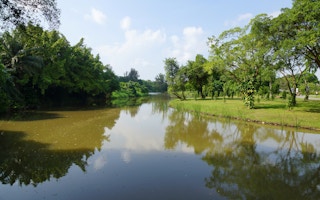Home to the majority of the world’s population, it is increasingly recognised that the battle for sustainability will be won or lost in cities. Urban areas concentrate and magnify many of the key challenges captured in the 17 Sustainable Development Goals (SDGs).
Across the globe, responses to emerging 21st century challenges continue to rely on the entrenched technocratic approaches of the 20th century, in many cases perpetuating existing institutional regimes and conventional water management approaches, rather than adopting more integrated, decentralised and innovative place-based approaches.
In the developed world, many strategies devised to meet emerging urban water challenges are encumbered by this ‘path-dependent lock-in’ where institutional legacy limits the range of acceptable solutions/interventions to only those that fit within the existing institutional paradigm.
Developing countries, where infrastructure and institutions are not well established, are more flexible and conducive to contemporary urban water solutions. For this reason, cities in developing countries are well placed to leapfrog directly to a water-sensitive city, rather than follow the organic evolution of urban water infrastructure and institutions that we see in many cities in developed countries.
“
A leapfrogging pathway will enable developing economies to skip over inferior, less efficient, more expensive or more polluting technologies, and proceed directly to the implementation of more integrated and sustainable approaches.
Much of the financial investment required to transform cities in developed countries to more sustainable, resilient, water-sensitive cities can in fact be avoided when creating water-sensitive cities in developing countries. This is on the proviso that international aid and loan programmes do not inadvertently impose developed-world traditional thinking, planning, and design of water systems onto these countries.
Leapfrogging is simply about capturing and building on advancements and innovations in policies and technologies achieved in other places (typically the developed world) and avoiding the traditional evolutionary approach to infrastructure development and management. Promoting a leapfrogging pathway requires a shift in urban water infrastructure development strategies to embrace the notion that the management of sewage and stormwater as a resource can concurrently address sanitation and flood mitigation, while significantly enhancing the reliability of water supply services.
Promoting a whole-of-government approach to infrastructure investment and management, and integrating urban water services with spatial planning, are key catalysts for leapfrogging. One example is flood risk management and how a holistic approach to it can also provide greater water supply security to a city. Early planning and delineation of open spaces and blue/green corridors for safe passage of floodwater can avoid encroachment of urban development into these natural flood paths.
Historically, encroachment into these pathways has increased the flood risk to inhabitants, and over time, leads to expensive flood mitigation retrofit works in built-up areas like straightening and concrete lining of urban drains and waterways. Ironically, some cities are now embarking on expensive retrofits to undo earlier flood mitigation works; converting concrete drains back to more naturalised waterways – another avoidable expense in a leapfrogging scenario.
In this example of a leapfrogging scenario, green infrastructure is used to support decentralised water services. The delineated blue/green corridors become the focal points for local drainage and can be designed as infrastructure for:
- Treatment and storage of stormwater as a resource during smaller, lower intensity and frequent storm events.
- Community recreational purposes as parks and gardens.
- Enhanced amenity and ecological biodiversity.
- Food production.
Recent research has also shown them to also have a significant influence on local microclimate.

Above is a time-series of the construction and establishment of a blue-green corridor in Lynbrook, Victoria, Australia providing multiple benefits including flood control, environmental protection in the form of storm water quality treatment and landscape aesthetic. Corridors like these present an opportunity to support treatment and storage of stormwater as a resource during smaller, lower intensity and frequent storm events; community recreation; enhanced amenity and ecological biodiversity; and productive landscapes.
A leapfrogging pathway will enable developing economies to skip over inferior, less efficient, more expensive or more polluting technologies, and proceed directly to the implementation of more integrated and sustainable approaches. This will enable developing cities to avoid the environmental, social and economic vulnerabilities that come from managing the water cycle in a fragmented way.
This is one of the ways the CRC for Water Sensitive Cities is partnering with ADB’s Future Cities Program to provide the knowledge partnership in their Finance ++ approach to improved project sustainability and effectiveness in cities across Asia and the Pacific.
Tony Wong is CEO of the Cooperative Research Centre for Water Sensitive Cities. This post is republished from the ADB Blog.











